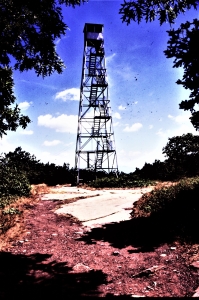Elevator in Time
On the Rocks; The Woodstock Times
Updated by Robert and Johanna Titus
You’ve likely been to the top of Overlook Mountain and know the site of its fire tower. Imagine for a moment that there was an elevator shaft up there. This is a special one, a time elevator, built for geologists to take them back into Woodstock’s distant past. This elevator takes you down into the earth, through the many layers of rock which make up Overlook. You don’t stop at floors; you stop at moments in time. There are four doors, each facing one of the four compass directions. When the elevator stops at some ancient moment, the door opens upon the landscape as it then was. The only flaw is that this elevator can only take you to those moments of time that are recorded within the strata of Overlook.

We go in, push a button and down we go. The first leg of our trip is not very long and not very far. The east-facing door opens only a few feet beneath the surface. It’s 365 million years ago and out there is a mountain range; the Acadian Mountains rise above where the Taconics are today. They tower to ten or fifteen thousand feet above sea level. Their peaks are snow-capped. Below the white, the colors grade from dark blue to purple to red to rose. The slopes are dry, barren of plants, and shimmering in the heat of a high sun. In the foreground lies an enormous deposit of sand and gravel. The surface is scarred with rills and gullies, but there’s no water; it’s the dry season now. The elevator’s east door closes and the west one opens. That landscape slopes off to the west where there are a few dry stream channels and along the dry banks a primitive yellow green foliage struggles. The west door closes and down we go.
A short trip takes us another thousand feet, down to 373 million years ago. The east door opens, and we view an active river flowing toward us. It’s at high water but not flooding. The south door opens, and we see a dense jungle of very primitive plants. They are unlike anything seen today. The upper limbs have a “fur” of short, simple leaves. Below the limbs, the tree trunks are ornamented with the scars left when similar leaves fell to the ground. The weedy ground crawls with centipedes, spiders, and other bugs. At least these are familiar, but there are no animals or birds, and without them, it is as quiet as can be – unnervingly still. The door shuts: down we go, another 500 feet.
All four doors open, and we see a shallow sea floor, but no water floods in. It’s 378 million years ago. Around us heavily armored, sluggish fish-like creatures swim close to the bottom. Only the presence of primitive clumsy-looking fins confirms that these are indeed fish. This marine world begins to look a little more familiar when we see that the sea floor is littered with clams and snails, but the rest of the shellfish defy description; this is an alien sea bottom. The doors close.
After another trip we reach 407 million years ago at a depth of nearly 8,000 feet beneath the top of Overlook Mountain. We are more than a mile beneath the surface. Again, all four of our elevator doors open. We gaze out onto what, at first, looks like a meadow. But it’s really a very shallow sea floor. The sandy bottom is brightly sunlit, white, and dotted with the green of marine algae. Beautiful creatures rise above the algae. They are simple animals with the odd name of “sea lilies.” The name is appropriate, however; they have long stems and are rooted into the sand bottom. At the top of each of the long stems are five brightly colored, delicately branched arms. Gentle marine currents pass across this meadow. The arms grasp at the waters, vainly it seems, reaching for food. The doors all shut.

Shortly, when they open again, we look out upon a bleak, sunbaked coastal landscape. All around are broad tidal flats. They were flooded recently, but today they bake in the sun. All around are mats of dark, green-brown, leathery algae. They are rotting in the sun, and they stink. In between the algal mats are pools of saltwater brine. They have been drying out and are rimmed by deposits of salt. It is a quiet, desolate, and dead place, but this is an important landscape. This is the goal of our journey. These are the oldest sediments of the Catskill sequence and this landscape, bleak as it is, marks the very beginning of Catskill history, 408 million years ago.
Contact the authors at randjtitus@prodigy.net. Join their facebook page “The Catskill Geologist.”





